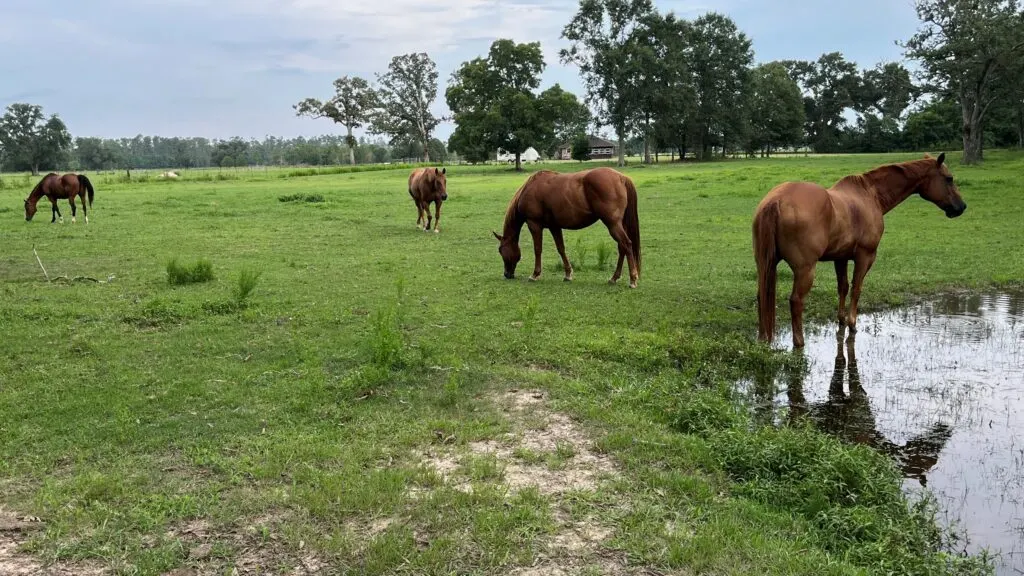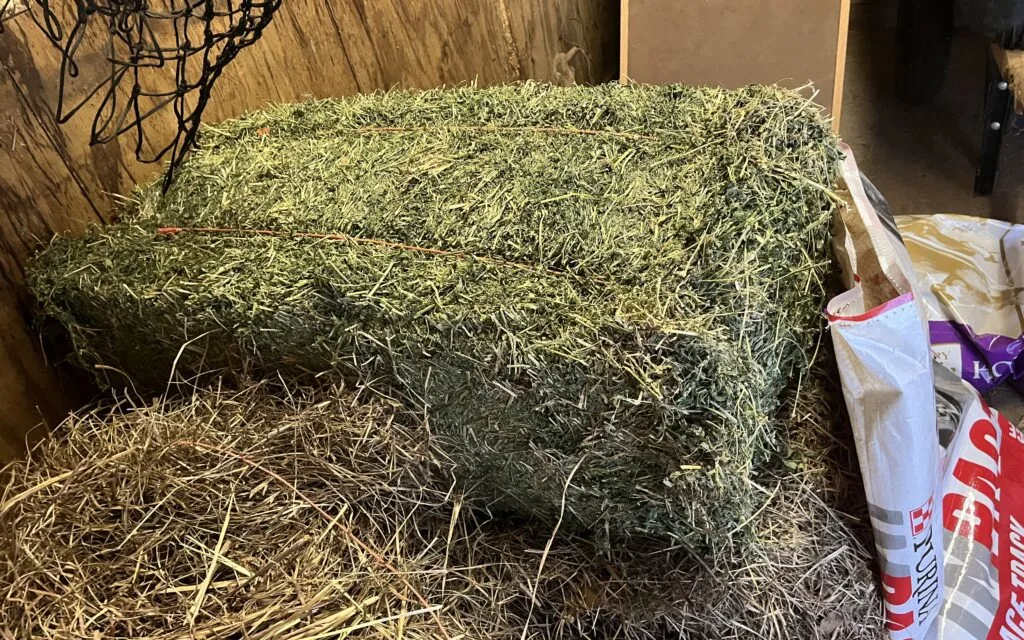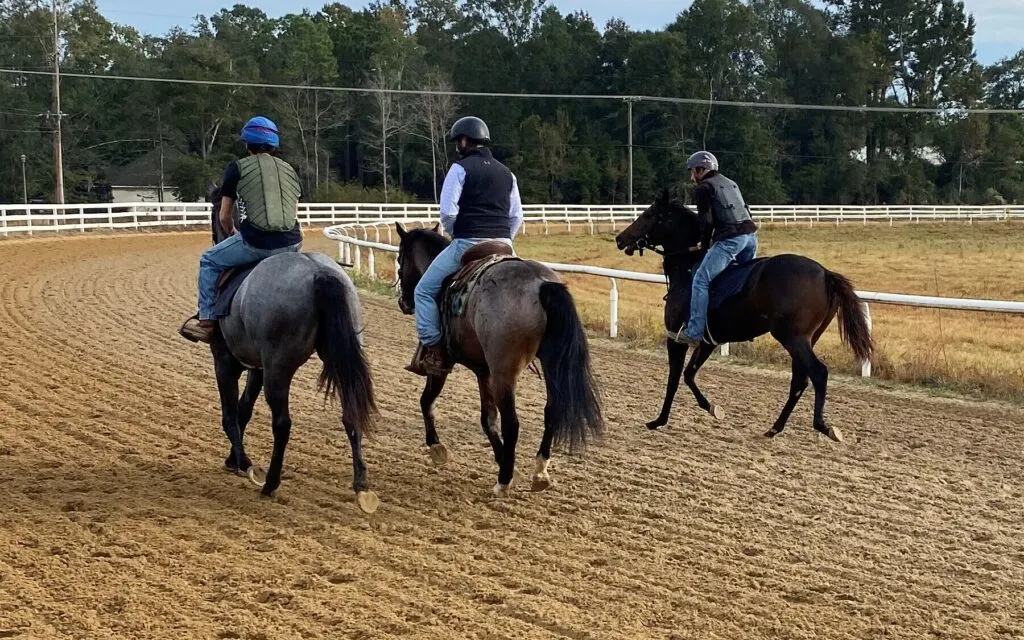Last updated: July 24, 2023
For those who have always dreamed of owning a horse, it’s important to remember that caring for one is a significant undertaking that goes beyond just riding and grooming.
Horse care requires attention and effort, from providing a safe and comfortable living environment to ensuring proper nutrition, exercise, and healthcare. However, with the right knowledge and commitment, you can ensure that your horse has the best possible quality of life.
Caring for a horse can seem daunting at first, but you can easily learn how to give your horse the best care possible. Whether you’re a seasoned horse owner or just getting your first horse, this guide will provide you with all the information you need to keep your horse happy and healthy.
Housing and Shelter
Providing a safe, secure, and comfortable living environment for a horse is crucial to its well-being. A horse’s living space should be designed to meet its physical and emotional needs and should be free from hazards.

A safe living space is essential to prevent injuries and accidents. This includes ensuring that the horse has access to shelter from the elements, such as wind, rain, and extreme heat or cold.
It also means eliminating potential hazards, such as sharp objects or tripping hazards, and ensuring that the living space is well-ventilated and has sufficient lighting. We plow and harrow our pastures to ensure no hidden holes could cause our horses to trip and injure themselves.
A secure living space is important for a horse’s emotional well-being. Horses are social animals and thrive when they have a sense of security and routine. A secure living space can provide a sense of stability and familiarity for a horse, which can help reduce stress and anxiety.
A comfortable living space is essential for a horse’s physical health. A horse’s living space should be spacious enough to move around and stretch its legs and have a comfortable surface for it to stand on.
In summary, providing a safe, secure, and comfortable living environment for a horse is essential to its overall well-being and happiness. It is important to carefully consider a horse’s physical and emotional needs when designing its living space and to ensure that it is free from hazards and distractions.

Types of Housing and Shelter
There are several different types of housing options for horses, including stalls, paddocks, and pastures. Horse stalls can be a good option for horses that need to be kept indoors for health or safety reasons or for horses that need to be protected from extreme weather conditions.
A horse stall is a small, enclosed area within a barn that is used to house a single horse. A standard stall size is 12 x 12, and this is typically large enough for a horse to move around and stretch its legs.
Stalls have a door or gate that can be opened and closed to allow the horse to enter and exit.
There are several key features that a stall should have to ensure the health and well-being of the horse. These include:
- Ventilation: A horse’s living space should have good airflow to help prevent respiratory problems and other health issues. This can be achieved through the use of windows, doors, and vents.
- Lighting: A horse’s living space should have sufficient lighting to allow the horse to see clearly and to help prevent injuries. This can be achieved through the use of natural light or artificial lighting.
- Drainage: A horse’s living space should have proper drainage to prevent standing water and mud, which can cause health problems and injuries. This can be achieved through the use of gutters, drains, and other drainage systems.
- Comfortable flooring: A horse’s living space should have a comfortable flooring surface and clean bedding, such as wood shavings. This can help prevent injuries and soreness.
- Access to food and water: A horse’s living space should have access to clean, fresh water and enough food to meet its nutritional needs. This can be achieved through the use of feeders and water troughs.
- Safety: A horse’s living space should be free from hazards such as sharp objects or tripping hazards. This can help prevent injuries and accidents.
Paddocks are outdoor areas that are fenced in to provide a space for horses to move around and graze. Paddocks can be a good option for horses needing more space and pasture access and can be used in conjunction with stalls.
Pastures are large, open areas that are typically used for grazing horses. Pastures can provide horses with a natural environment to live in and can be a good option for horses that need a lot of space and access to grass.
However, it is important to manage pastures properly to prevent overgrazing and ensure they are free from hazards such as poisonous plants. It is also critical to have good fencing, such as board or wire mesh; we never use barbed wire fencing for our horse pastures.
In summary, the type of housing option that is best for a horse will depend on its individual needs and circumstances. Stalls can be a good option for horses that need to be kept indoors, while paddocks and pastures can be a good option for horses that need more space and access to pasture. It is important to carefully consider the needs of a horse when deciding on a housing option.

Feeding and Nutrition
Feeding and nutrition are important aspects of horse care that are essential for maintaining a horse’s health and well-being. Providing a balanced and appropriate diet for a horse is essential to meet its nutritional needs and to support its growth, development, and performance.
There are several different types of feed and forage your horse may need to meet its nutritional needs. These include pasture grass, hay, grains, and supplements.
Pasture grass
Pasture grass is an important source of nutrition for horses, providing them with fiber and other essential nutrients for their health and well-being.
Several different types of pasture grasses are suitable for horses, including cool-season grasses such as fescue, bluegrass, and ryegrass, and warm-season grasses such as bermudagrass and orchard grass.
The type of pasture grass that is best for a horse will depend on its needs and the climate in which it lives. It is important to manage pasture grass properly to ensure that it remains healthy and nutritious for horses.
This includes rotating the pasture to allow grasses to recover and regrow, controlling weeds and pests, and providing adequate water and nutrients. It is also important to monitor the horse’s grass intake and provide additional hay or grain as needed to meet its nutritional needs.

Horse hay
Hay is dried grass made into bales and is an important source of fiber and nutrients for horses.
Here are the most commonly used hay and their nutritional values:
| Type of Hay | Protein (% dry matter) | Fiber (% dry matter) | Energy (Mcal/kg) |
|---|---|---|---|
| Alfalfa hay | 15-20 | 25-30 | 1.6-1.8 |
| Grass hay | 5-10 | 25-35 | 1.2-1.4 |
| Oat hay | 7-9 | 30-35 | 1.3-1.5 |
| Timothy hay | 7-10 | 30-35 | 1.4-1.6 |
| Clover hay | 10-12 | 30-35 | 1.4-1.6 |
Note: These values are approximate and may vary depending on the quality and maturity of the hay.
Different types of hay have different nutritional values, with alfalfa hay generally having the highest protein content. Most hay is high in fiber and can be a good source of energy for horses.
Grains
Grains are a type of feed that is high in protein and energy and can be fed to horses to support their growth and development or to provide extra energy for work or competition.
| Type of Grain | Protein (% dry matter) | Fiber (% dry matter) | Energy (Mcal/kg) |
|---|---|---|---|
| Oats | 10-12 | 7-12 | 1.2-1.4 |
| Corn | 8-10 | 3-5 | 1.3-1.5 |
| Barley | 10-12 | 6-8 | 1.2-1.4 |
| Wheat | 12-14 | 3-5 | 1.3-1.5 |
| Soybeans | 36-40 | 7-10 | 1.4-1.6 |
| Sweet feed | 10-14 | 3-5 | 1.3-1.5 |
Note: These values are approximate and may vary depending on the quality and processing of the grain.
Sweet feed is a grain-based feed typically made from a mixture of grains, such as oats, corn, and barley, and is often sweetened with molasses or other additives. It is commonly fed to horses to supplement their diet to provide additional energy and nutrients.
Sweet feed has a moderate protein and energy content and is low in fiber. It is important to choose the right sweet feed for a horse’s needs and follow the manufacturer’s recommendations for feeding amounts.
It is also important to remember that sweet feed should be fed in moderation as part of a balanced diet for horses. Whether or not your horse needs grain depends on its energy output.
Supplements
Supplements are nutrients that can be added to a horse’s diet to meet specific needs or compensate for deficiencies in the horse’s diet. Here’s a look at some of the common reasons people add supplements to their horse’s diet:
There are several reasons why someone might choose to feed their horse supplements:
- To compensate for deficiencies in the horse’s diet: Supplements can be used to provide additional nutrients that may be missing from a horse’s diet, such as vitamins, minerals, or amino acids.
- To support the horse’s health and well-being: Supplements can be used to support a horse’s health and well-being in various ways, such as helping to maintain healthy hooves, skin, and coats or supporting joint health and mobility.
- To improve performance: Supplements can be used to enhance a horse’s performance in a specific discipline, such as racing or endurance.
- To address specific health concerns: Supplements can be used to address specific health concerns in a horse, such as digestive problems or allergies.
When choosing feed for a horse, there are several factors to consider. These include the horse’s age, weight, and activity level. It is important to choose feed appropriate for the horse’s needs and follow the manufacturer’s recommendations for feeding amounts.
It is also important to monitor a horse’s weight and adjust the feed amount accordingly to prevent weight gain or loss. In summary, feeding and nutrition are important aspects of horse care that are essential for maintaining a horse’s health and well-being.
Providing a balanced and appropriate diet for a horse, including hay, grains, and supplements as needed, and ensuring that the horse has access to clean, fresh water, is essential for the horse’s overall health and happiness.

Grooming and Hygiene
Grooming and hygiene are important aspects of horse care that are essential for maintaining a horse’s physical and mental well-being. Regular grooming helps to keep a horse’s coat and skin healthy and can also help to strengthen the bond between horse and owner.
I also use this time to check my horse for any signs of illness or injury. For example, when lifting their feet, rub your hand on their shins and tendons to feel for heat, and when you brush their back, you can also check their topline.
Several different grooming tools and techniques can be used to care for a horse. These include brushes, combs, and hoof picks. Brushes and combs can be used to remove dirt, tangles, and debris from a horse’s coat and mane, while hoof picks can be used to clean out a horse’s hooves.
Using the right tools and techniques for the job is important, and you must be gentle and patient when grooming a horse. In addition to grooming the horse’s coat and hooves, it is also important to pay attention to other aspects of the horse’s hygiene.
This includes regularly cleaning the horse’s living space and equipment and ensuring that the horse has access to fresh water. In summary, grooming and hygiene are important aspects of horse care that are essential for maintaining a horse’s physical and mental well-being.

Exercise and Training
Exercise and training are important aspects of horse care that are essential for maintaining a horse’s physical and mental health. Regular exercise helps to keep a horse fit and healthy and can also help to prevent boredom and behavior problems.
There are several different types of exercise and training options for horses, including riding, lunging, and groundwork. Riding is the most common form of exercise for horses and can be done in various disciplines, such as dressage, jumping, or trail riding.
Lunging is a type of exercise in which a horse is made to walk, trot, or canter in circles around the handler, and it can be a good way to improve a horse’s balance and coordination. Groundwork is a type of training that is done on the ground and can include activities such as leading, backing, and steering.
When developing an exercise and training plan for a horse, there are several factors to consider. These include the horse’s age, ability, and goals. It is important to choose activities appropriate for the horse’s level of fitness and experience and gradually increase the intensity and duration of the exercise over time.
Health and Wellness
Health and wellness are important aspects of horse care that are essential for maintaining a horse’s overall well-being. Monitoring a horse’s health and well-being is an important part of responsible horse ownership and can help to prevent and manage illness or injury.
Here is a YouTube video that provides helpful information about horse health.
There are several signs and symptoms of illness or injury to watch for in a horse. These include changes in appetite, behavior, or appearance, such as weight loss, lethargy, or lameness. It is important to seek veterinary care if a horse exhibits any of these signs, as early intervention can often help to prevent more serious problems.
In addition to monitoring a horse’s health, it is also important to take steps to prevent illness and injury. This includes providing a safe, secure, and comfortable living environment for the horse and regular vaccinations and deworming.
Conclusion
In conclusion, caring for a horse requires significant time and effort, but it can also be a rewarding and fulfilling experience. Maintaining a safe and comfortable home for your horse, and ensuring that it receives proper nutrition, grooming, exercise, and healthcare, are all crucial components of responsible horse care.
Owners can help ensure that their horses are happy, healthy, and well-adjusted by taking the steps necessary to provide the best care possible.
